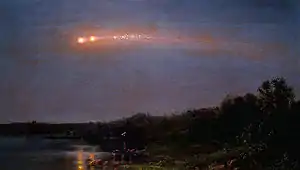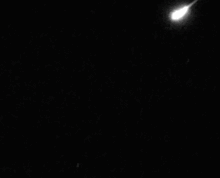Meteor procession
A meteor procession occurs when an Earth-grazing meteor breaks apart, and the fragments travel across the sky in the same path. According to physicist Donald Olson, only four occurrences are known:[1]
- 18 August 1783 Great Meteor[1][2]
- 20 July 1860 Great Meteor; believed by Olson to be the event referred to in Walt Whitman's poem Year of Meteors, 1859–60[3][4]
- 21 December 1876 Great Meteor; sighted over Kansas, Missouri, Illinois, Indiana, Ohio, Pennsylvania[5]
- 9 February 1913 Great Meteor Procession; a chain of slow, large meteors moving from northwest to southeast, sighted over North America, particularly in Canada, the North Atlantic and the Tropical South Atlantic

Oil painting by Frederic Edwin Church, The 1860 Great Meteor
See also
- 1972 Great Daylight Fireball – Atmospheric phenomenon
- Bolide – Extremely bright meteor
- Comet breakup – Natural object in space that releases gas
- Forensic astronomy – Study of past celestial appearances
- Green fireballs – Unidentified flying objects
- List of Earth-crossing asteroids
- Meteor shower – Celestial event caused by streams of meteoroids entering Earth's atmosphere
- Unidentified flying object – Airborne, submerged, and transmedium phenomena considered unusual and unidentified
References
- Falk, Dan (1 June 2010). "Forensic astronomer solves Walt Whitman mystery: CultureLab (blog)". New Scientist. Archived from the original on 21 March 2016. Retrieved 8 February 2023.
- "Notes and Queries". Journal of the Royal Astronomical Society of Canada. 8: 221–222. June 1914. Bibcode:1914JRASC...8..221. Retrieved 8 February 2023.
- "Forensic astronomer solves Walt Whitman mystery". New Scientist. 1 June 2010. Retrieved 8 February 2023.
- "150-year-old meteor mystery solved". MSNBC. 2 June 2010. Archived from the original on 5 June 2010. Retrieved 8 February 2023.
- Herschel, Alexander Stewart (1878). "Observations of luminous meteors". Report of the forty-seventh meeting of the British Association for the Advancement of Science: Held at Plymouth in August 1877. John Murray. pp. 149–153.
This article is issued from Wikipedia. The text is licensed under Creative Commons - Attribution - Sharealike. Additional terms may apply for the media files.
